AMD Athlon II X4 620 & 630: The First $99 Quad Core CPU
by Anand Lal Shimpi on September 16, 2009 12:00 AM EST- Posted in
- CPUs
3dsmax 9 - SPECapc 3dsmax CPU Rendering Test
Today's desktop processors are more than fast enough to do professional level 3D rendering at home. To look at performance under 3dsmax we ran the SPECapc 3dsmax 8 benchmark (only the CPU rendering tests) under 3dsmax 9 SP1. The results reported are the rendering composite scores:
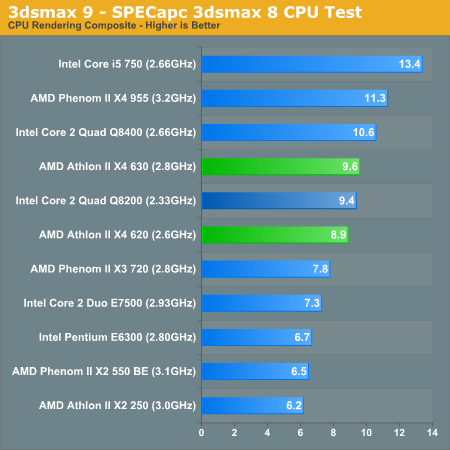
Offline 3D rendering should be another safe haven for the Athlon II X4. Core count matters and that's what AMD delivers. At $25 per core the Athlon II X4 620 is faster than even the X3 720. It's of course faster than any dual-core CPU in its price range, including the more expensive E7500. Intel's Core 2 Quad Q8200 is around 6% faster but costs 60% more.
Cinebench R10
Created by the Cinema 4D folks we have Cinebench, a popular 3D rendering benchmark that gives us both single and multi-threaded 3D rendering results.
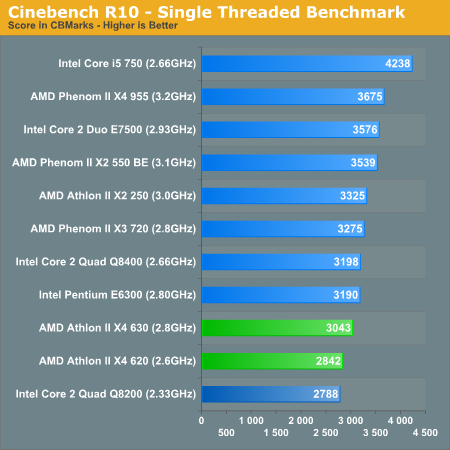
Single threaded performance is where the Athlon II X4 suffers the most. It's competitive but still slower than cheaper dual-core CPUs. This is the classic trade off for all pre-Lynnfield quad-core CPUs, you give up single threaded performance for multi-threaded performance. Luckily for AMD, Intel's Core 2 Quads suffer the same fate. While the Athlon IIs find themselves at the bottom of this chart, the Q8200 is the slowest chip here.
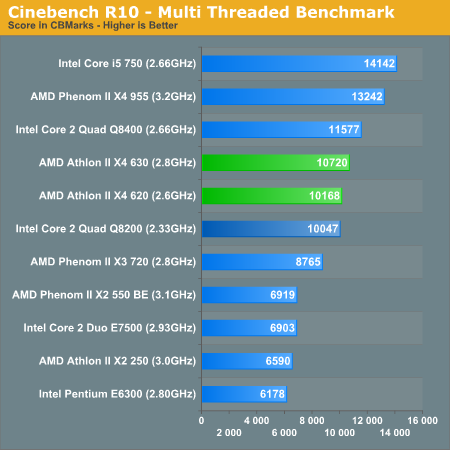
Turn up the thread count and the Athlon II shines once more. Again, the 620 is about the same speed as the Q8200, but slower than the Q8400. Just where it needs to be.
POV-Ray 3.73 beta 23 Ray Tracing Performance
POV-Ray is a popular, open-source raytracing application that also doubles as a great tool to measure CPU floating point performance.
I ran the SMP benchmark in beta 23 of POV-Ray 3.73. The numbers reported are the final score in pixels per second.
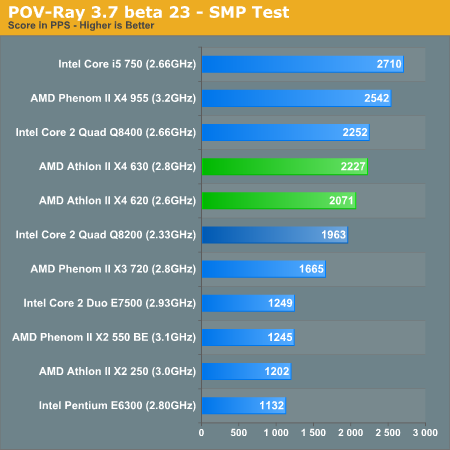
At this point I couldn't write a more competitive position for AMD. The Athlon II X4 continues to do very well in our 3D rendering tests.
Blender 2.48a
Blender is an open source 3D modeling application. Our benchmark here simply times how long it takes to render a character that comes with the application.
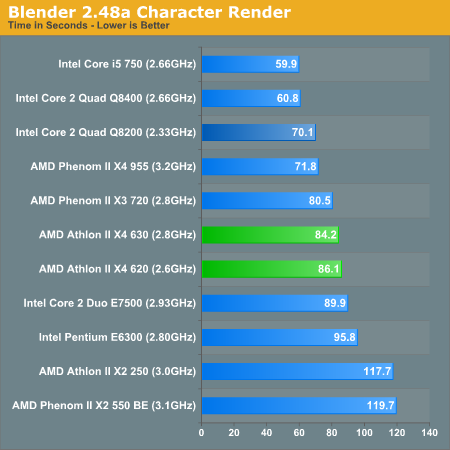
Our Blender test has traditionally favored Intel architectures, and here we see the first signs of the Athlon II X4 not being able to keep up. The Phenom II X3 720 and Core 2 Quad Q8200 are both faster, but compared to Intel's similarly priced dual-core offerings AMD is still quicker.










150 Comments
View All Comments
the zorro - Thursday, September 17, 2009 - link
the turbo overclocking is plain overclocking of all lynnfield cores at least 600 mhz and you are comparing lynfield overcloded results versus phenom 2 955 stock speeds.phenom 2 is much better than lynnfied 750 and when overclocked to 4ghz remains at 55 C while lynnfield temps are almost 100C. which sucks.
all the 'advantage' of lynnfied in these results comes from benchmarking an overclocked processor and present it as if it were stock speed, which is illegal
silverblue - Thursday, September 17, 2009 - link
Wrong. I'll help you here...i5 750
Default: 2.66GHz
4 cores: 2.93GHz 3 cores: 2.93GHz 2 cores: 3.06GHz 1 core: 3.20GHz (gains: 266MHz/266MHz/400MHz/533MHz)
i7 860
Default: 2.80GHz
4 cores: 3.06GHz 3 cores: 3.06GHz 2 cores: 3.33GHz 1 core: 3.46GHz (gains: 266MHz/266MHz/533MHz/667MHz)
(all data reassembled from the second table at http://www.anandtech.com/cpuchipsets/showdoc.aspx?...">http://www.anandtech.com/cpuchipsets/showdoc.aspx?...
The turbo mode gives a minimum boost of 266MHz and a maximum of either 533MHz for the i5 or 667MHz for the i7. NOT 600MHz for all cores. Quite where you got that from is beyond me. Additionally, Turbo is a 100% legitimate technology. Would you be happier if the default clock was throttled?
As for illegal... we have a word in the UK for this sort of comments, and it's "bollocks".
Eeqmcsq - Thursday, September 17, 2009 - link
Good chart, though you linked to the wrong page. It was on the Turbo Mode page. I have no idea how I missed that chart the first time I read the article.But for the i5 750, if the lowest GHz Turbo mode will operate at is 2.93 GHz, why doesn't Intel just call it an i5 750 at 2.93 GHz, instead of 2.66 GHz?
silverblue - Thursday, September 17, 2009 - link
My bad - the link has a ) after it which sends you to the intro page. I should've put a space after the link.At least you checked through to find it... I doubt "the zorro" has bothered as of yet.
You make a very good point about Turbo but it's not as if Intel is pretending it doesn't exist or it's disabled; it should be relatively easy for people to make comparisons using the benchmarks in this article as well as others. I suppose it may have helped if there was data suggesting the clock speed at the time of a specific test, but I can't imagine that'd be a very easy thing to do especially if threads are being bounced across cores and as a result, the clock speed is constantly fluctuating. The alternative would've been to disable Turbo and that would've prevented people like "the zorro" from his pointless tirade on here, but they would've been disabling a feature of the processor to test it against rivals that lack that feature.
Eeqmcsq - Thursday, September 17, 2009 - link
> I suppose it may have helped if there was data suggesting the clock speed at the time of a specific test, but I can't imagine that'd be a very easy thing to do especially if threads are being bounced across cores and as a result, the clock speed is constantly fluctuating.- No, but the troll does make one point that I agree with. When an i5 is run with Turbo mode, Anand's charts should NOT list that it is at 2.66 GHz. He should list it as 2.93-3.20 GHz, especially if it is 100% certain that Turbo mode NEVER reaches the baseline Turbo off clock of 2.66 GHz.
> The alternative would've been to disable Turbo and that would've prevented people like "the zorro" from his pointless tirade on here, but they would've been disabling a feature of the processor to test it against rivals that lack that feature.
- Well, I've asked for the same thing, but for different reasons that I don't want to repeat in this comment or I'll sound like a troll. :)
the zorro - Thursday, September 17, 2009 - link
if you are an accountant and do the same thing and try to present false results as real then you would go to jail.you can call a bank robbery an 'auto loan' but still is robbery and you still go to jail.
people is not stupid.
silverblue - Thursday, September 17, 2009 - link
AMD, please just incorporate a turbo mode into your next CPUs so we can get rid of trolls like this one. Do it for me.Please.
the zorro - Thursday, September 17, 2009 - link
no amd wont do that.why?
because a platform at stock speed is more stable than other that is auto overclocking, also intel created the turbo crap story to charge for the overclocking.
yes intel is charging their users for the overclocking,now overclocking is a feature and intel charges for it.
amd phenom 2 overclocking is free.
try to auto overclock a server, that is not good and creates instability in the platform.
silverblue - Thursday, September 17, 2009 - link
And if they do, oh what will you do then?Additionally, try to explain to me what the 965 BE is other than an overclocked variant of the 955, which in turn was an overclocked variant of the 945. Isn't it interesting how none of these overclocks better than the others, and why the 965 BE has a higher TDP than the 955?
You act as if AMD and Intel have never produced an overclocked variant of any of their CPUs until Nehalem turned up.
the zorro - Thursday, September 17, 2009 - link
i can see that you have no clue, when a new processor is introduced that is 200 mhz faster than another model, is not an overclocked processor, is a more refined silicon, with better electrical properties and more stable at highers speeds. and also with higher overclocking headroom.